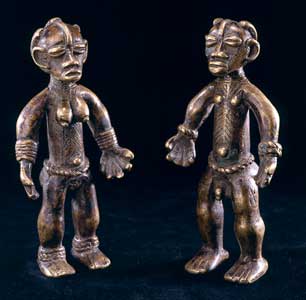Pair of Dan Bronze Sculptures of a Man and Woman, 19th Century CE - 20th Century CE
Bronze
3.75 x 7.75
PF.4996 (LSO)
This powerful pair of brass sculptures depicting a male and female was made by the Dan, one of Liberia’s most artistically prolific groups. They are in a dynamic standing pose,...
This powerful pair of brass sculptures depicting a male and female was made by the Dan, one of Liberia’s most artistically prolific groups. They are in a dynamic standing pose, with muscular legs, long torsos with extensive pinnate scarifications, unusually large hands, bracelets and ornate belts. Their heads are cast in the traditional style, with coffee-bean eyes and mouth, large ears, an inverted T nose and triple crested coiffures. The female additionally has anklets on both legs.
The Dan are a farming tribe, settled in the semi-wooded areas of Liberia and the Ivory Coast. While beholden to agriculture, much of their mythology and social structure is based upon the forest and its fiercer creatures – the Leopard Society is the main organ of social control. For example, initiates spend up to four months alone in the forest before they are permitted to enter maturity. Dan society was originally a string of spatially-proximate but socially distinct communities, and while they are now – technically at least – centralised, their diversity has found expression in the range of masks and other artefacts that they manufacture.
It is face masks for which the Dan are best known; there was scarcely a social function that did not have its own mask prior to the 1960s. There are masks for fire-watching (= fire warden), social adjudicators, warriors, debt collectors, delinquents and warriors, and others for enlisting workers to clear paths, to catch runaway wives, to race unmasked athletes (“runner masks”) to snatch feast food to serve to children and even for spying. Masks were inherited through lineages, kept on altars and endowed with libations. However, figures are far rarer, and their usage is thus far less systematised. The only accounts of figures of this sort pertain to the habit of prominent chiefs who wish to honour their favourite wives. The figures were cared for, anointed and kept by the wife in question, and they were only seen in the event of dignitaries’ visitations. No mention is made of metal figures, but metal is known to have been a major status symbol in all African groups, and it is likely that these figures represent conspicuous consumption by a social elite.
This is an impressive pair of African sculptures.
The Dan are a farming tribe, settled in the semi-wooded areas of Liberia and the Ivory Coast. While beholden to agriculture, much of their mythology and social structure is based upon the forest and its fiercer creatures – the Leopard Society is the main organ of social control. For example, initiates spend up to four months alone in the forest before they are permitted to enter maturity. Dan society was originally a string of spatially-proximate but socially distinct communities, and while they are now – technically at least – centralised, their diversity has found expression in the range of masks and other artefacts that they manufacture.
It is face masks for which the Dan are best known; there was scarcely a social function that did not have its own mask prior to the 1960s. There are masks for fire-watching (= fire warden), social adjudicators, warriors, debt collectors, delinquents and warriors, and others for enlisting workers to clear paths, to catch runaway wives, to race unmasked athletes (“runner masks”) to snatch feast food to serve to children and even for spying. Masks were inherited through lineages, kept on altars and endowed with libations. However, figures are far rarer, and their usage is thus far less systematised. The only accounts of figures of this sort pertain to the habit of prominent chiefs who wish to honour their favourite wives. The figures were cared for, anointed and kept by the wife in question, and they were only seen in the event of dignitaries’ visitations. No mention is made of metal figures, but metal is known to have been a major status symbol in all African groups, and it is likely that these figures represent conspicuous consumption by a social elite.
This is an impressive pair of African sculptures.



